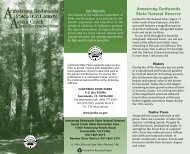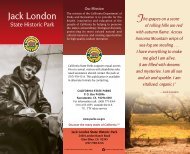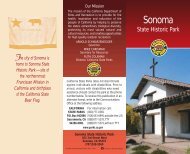Download the Official Fort Ross State Historic Park Map/Brochure
Download the Official Fort Ross State Historic Park Map/Brochure
Download the Official Fort Ross State Historic Park Map/Brochure
You also want an ePaper? Increase the reach of your titles
YUMPU automatically turns print PDFs into web optimized ePapers that Google loves.
The Russia-American Company’s<br />
Alexander Baranov sent his manager Ivan<br />
Kuskov to locate a California site that could<br />
serve as a trading base. Kuskov arrived in<br />
Bodega Bay on <strong>the</strong> ship Kodiak in January of<br />
1809 and remained until late August. He and<br />
his party of 40 Russians and 150 Alaskans<br />
explored <strong>the</strong> entire region, taking more than<br />
2,000 sea otter pelts back to Alaska.<br />
Kuskov returned to California to establish<br />
a Russian outpost at Metini, 18 miles north<br />
of Bodega. The site had plentiful water, good<br />
soil, forage and pasture, and a nearby supply<br />
of redwood for construction. The village’s<br />
relative inaccessibility from <strong>the</strong> Spanishoccupied<br />
territory to <strong>the</strong> south also gave <strong>the</strong><br />
settlers a defensive advantage.<br />
Ivan Kuskov,<br />
first manager of <strong>Fort</strong> <strong>Ross</strong><br />
In 1812 Kuskov<br />
brought 25<br />
Russians and<br />
80 Alaskans to<br />
build houses<br />
and a stockade,<br />
establishing a<br />
colony to grow<br />
wheat and o<strong>the</strong>r<br />
crops for Russians<br />
living in Alaska,<br />
hunt marine<br />
mammals, and<br />
trade with Spanish California. On August 13,<br />
1812, <strong>the</strong> colony was formally dedicated and<br />
renamed “<strong>Ross</strong>” to honor its connection with<br />
Imperial Russia—or “<strong>Ross</strong>iia.” The colonists<br />
called <strong>the</strong>ir new home <strong>Fort</strong>ress <strong>Ross</strong> or<br />
settlement <strong>Ross</strong>.<br />
Life at <strong>the</strong> <strong>Ross</strong> Colony<br />
The newcomers built redwood structures<br />
and a wooden palisade with two cannonfortified<br />
blockhouses on <strong>the</strong> north and<br />
south corners. A well in <strong>the</strong> center of <strong>the</strong><br />
fort provided emergency water. The bell<br />
tower stood in <strong>the</strong> east corner; <strong>the</strong> interior<br />
contained <strong>the</strong> manager’s two-story house,<br />
<strong>the</strong> clerks’ quarters, artisans’ workshops,<br />
and Russian officials’ barracks.<br />
In <strong>the</strong> mid-1820s, <strong>the</strong> chapel<br />
was built. Outside <strong>the</strong> stockade<br />
to <strong>the</strong> northwest, lower-ranking<br />
employees and people of mixed<br />
ancestry gradually established a<br />
village, and to<br />
<strong>the</strong> southwest<br />
<strong>the</strong> native<br />
Alaskans<br />
lived in<br />
ano<strong>the</strong>r<br />
village on a<br />
bluff above<br />
<strong>the</strong> ocean.<br />
The only<br />
surviving<br />
original<br />
structure at<br />
<strong>Fort</strong> <strong>Ross</strong> is <strong>the</strong> Rotchev House, an e xisting<br />
building renovated for Alexander Rotchev,<br />
<strong>the</strong> last manager of <strong>Ross</strong>. Several o<strong>the</strong>r<br />
buildings have been reconstructed: <strong>the</strong> first<br />
Russian Orthodox chapel south of Alaska,<br />
<strong>the</strong> stockade, and four o<strong>the</strong>r buildings—<strong>the</strong><br />
first manager’s home (Kuskov House),<br />
<strong>the</strong> <strong>Official</strong>s’ Barracks, and two corner<br />
blockhouses.<br />
Only a small number of Russians lived<br />
at <strong>Ross</strong>; few were women. <strong>Ross</strong> was a<br />
successfully functioning multicultural<br />
settlement for at least thirty years. Settlers<br />
included Russians, Native Alaskans and<br />
Californians, and Creoles (individuals of<br />
mixed European and native ancestry).<br />
In addition to agriculture and hunting sea<br />
mammals, <strong>Ross</strong> colony industries included<br />
blacksmithing, tanning, brickmaking<br />
and shipbuilding. The first ship built in<br />
California, Rumiantsev, was completed<br />
Russian flag over <strong>the</strong> Rotchev House






